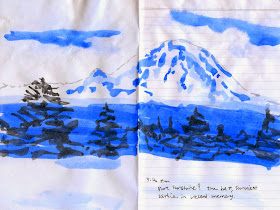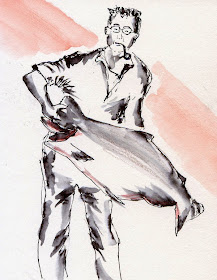 |
6/28/14 Diamine Chocolate Brown, Grey and Pilot Iroshizuku Ku-Jaku inks,
Sailor pen, Zig markers, Canson XL 140 lb. paper |
The Greenwood Car Show was so much fun last year that I hated the
possibility of missing it. The weather forecast for today was rain, but the bright
spots of blue among the clouds made me optimistic. I took a chance and headed
for the Greenwood neighborhood, fairly
certain that I could get a few sketches done before the clouds split open.
My first sketch of a 1954 Kaiser Darrin KF-161 Roadster –
which has a sliding door! – went well, and by that I mean my sketch stayed dry.
By then it was actually warming up and sunnier, so I kept on walking down Greenwood
Avenue, where “a mile and a half” of hundreds of classic cars were on display
for the 22nd annual event.
 |
| 6/28/14 Pilot Iroshizuku Ku-Jaku and Diamine Grey inks, Pitt Artist Pen |
The next beauty to catch my eye was a ‘41 Chevy two-door sedan
in a gorgeous turquoise blue color. That sketch, too, went well – we both
stayed dry. When I finished, it was starting to spit a little, but I decided it
was going to stop soon, so I kept walking.
That’s when I spotted a blue convertible (I never got around
to reading its make and model), and you know how I feel about convertibles. Despite
the spitting rain that had turned to a drizzle, I decided to sketch it. Still in
denial when the drizzle turned quickly to rain (“it’s going to stop soon”), I
kept going. That’s when I realized I’d forgotten all about the finished sketch
of the turquoise Chevy on my sketchbook’s facing page, now just as drenched as
the sketch I had to abandon.
 |
| 6/28/14 Ink and rain. |













































